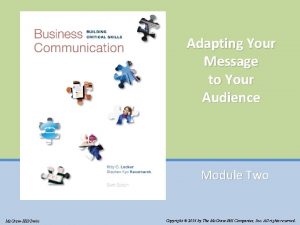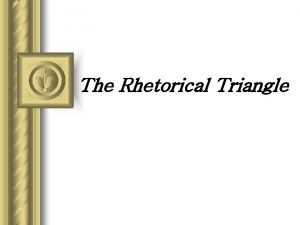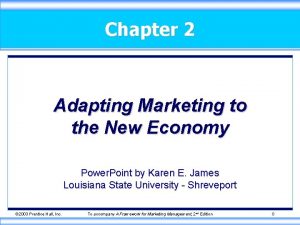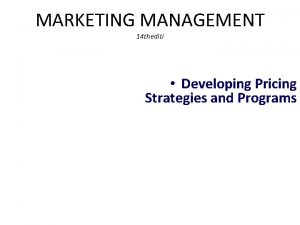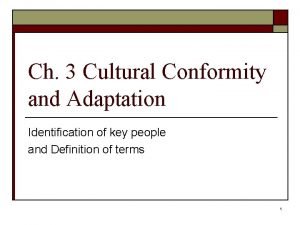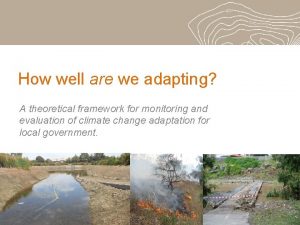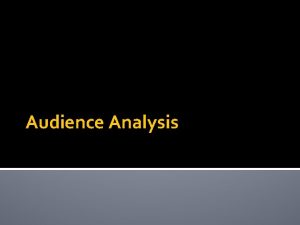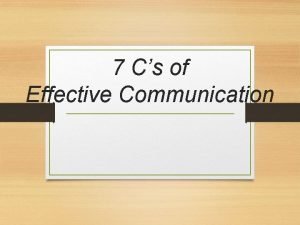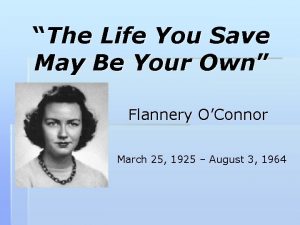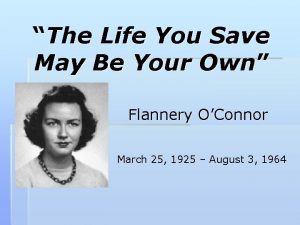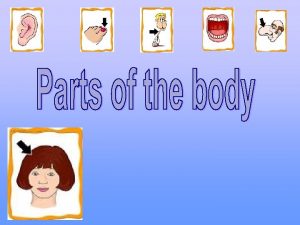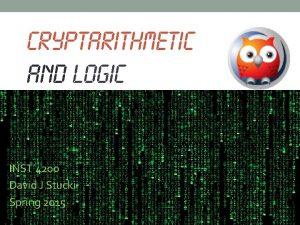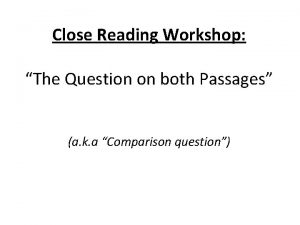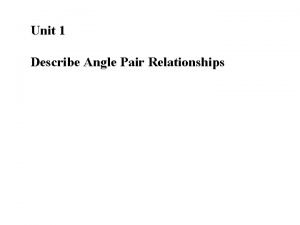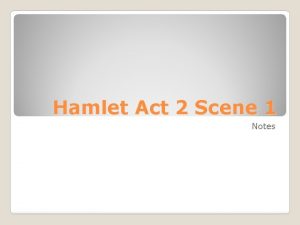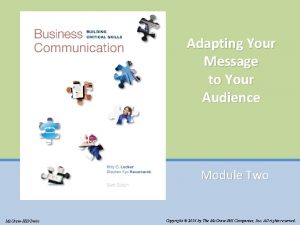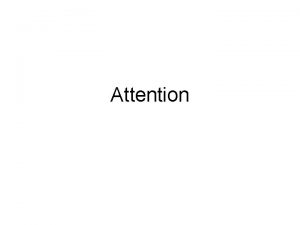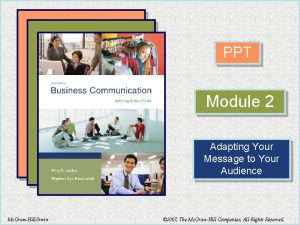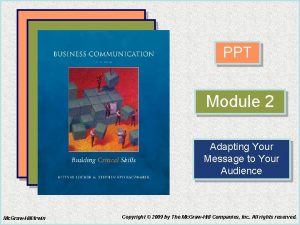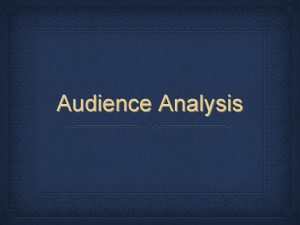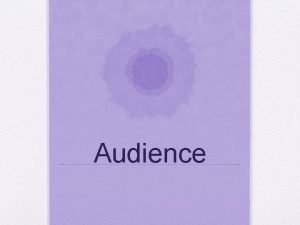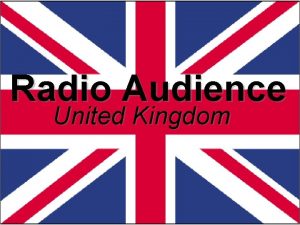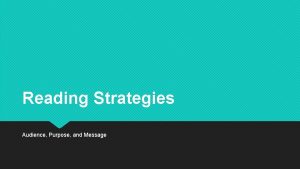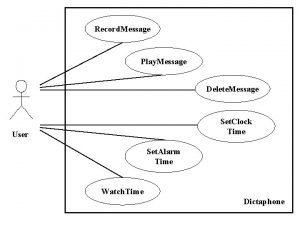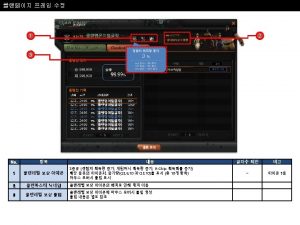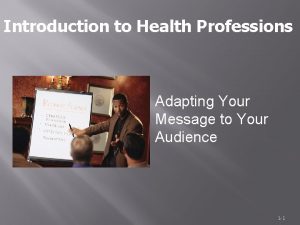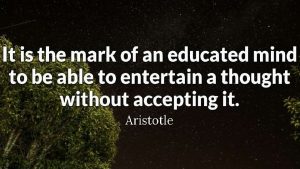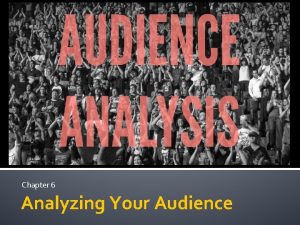Adapting Your Message to Your Audience Module Two







































- Slides: 39

Adapting Your Message to Your Audience Module Two © 2014 The Mc. Graw-Hill Companies, Inc. All rights reserved Mc. Graw-Hill/Irwin Copyright © 2014 by The Mc. Graw-Hill Companies, Inc. All rights reserved.

Audiences Understanding your audience is fundamental to the success of any message. You need to adapt your message to fit the audience's goals, interests, and needs. customers have enough options to deal only with companies that treat them respectfully.

Understanding What Your Organization Wants Succeeding in an organization depends first on understanding what “counts” at your organization. Ask your boss, “What parts of my job are most important? What’s the biggest thing I could do to improve my work? ” 2 -3

Who is my audience? More people than you might think! 9 In an organizational setting, a message may have five separate audiences. • • • The primary audience The secondary audience The initial audience A gatekeeper A watchdog audience

Who is my audience? 1. The primary audience will decide whether to accept your recommendations or will act on the basis of your message. You must reach the decision maker to fulfill your purposes.

Who is my audience? 2. The secondary audience may be asked to comment on your message or to implement your ideas after they've been approved. Secondary audiences can also include lawyers who may use your message—perhaps years later—as evidence of your organization's culture and practices.

Who is my audience? 3. The initial audience receives the message first and routes it to other audiences. Sometimes the initial audience also tells you to write the message.

Who is my audience? 4. A gatekeeper has the power to stop your message before it gets to the primary audience. A secretary who decides who gets to speak to or see the boss is a gatekeeper. Sometimes the supervisor who assigns the message is also the gatekeeper; however, sometimes the gatekeeper is higher in the organization. In some cases, gatekeepers exist outside the organization.

Who is my audience? 5. A watchdog audience, though it does not have the power to stop the message and will not act directly on it, has political, social, or economic power. The watchdog pays close attention to the transaction between you and the primary audience and may base future actions on its evaluation of your message.

Who Is My Audience? Watchdog audience 9 pays close attention to the transaction between you and the primary audience and may base future actions on its evaluation of your message 2 -10

The Audiences for a Marketing Plan 2 -11

The Audiences for a Consulting Report 2 -12

PAIBOC P What are your purposes in writing? A Who is (are) your audiences? I What information must your message include? 2 -13

PAIBOC B What reasons or reader benefits can you use to support your position? O What objections can you expect your reader(s) to have? C How will the context affect reader response? 2 -14

A Model of Two-Person Communication with Feedback Figure 2. 3 2 -15

The Communication Process To communicate, a person must first perceive a stimulus and then interpret what has been perceived. The person then chooses the information he or she wishes to send and puts it into a form for the audience. That action is called encoding.

The Communication Process The message is transmitted through a channel, such as a memo, a phone call, or an e-mail message. The audience receives the message and decodes, or makes sense, of it.

The Communication Process At any stage of the process, noise may interfere with communication. Noise can be physical, such as illegible handwriting, or psychological, such as the audience disliking the speaker.

The Communication Process v Perception: a person perceive a stimulus. v Interpretation: interpret what has been perceived. v Choice/Selection: the person chooses the information he or she wishes to send.

The Communication Process v Encoding: puts ideas into a form for the audience. v The message is transmitted through a channel, such as a memo, a phone call, or an e-mail message. v Decoding: extract meaning from the form.

The Communication Process Channel overload occurs when the channel cannot handle all the messages that are being sent. A small business may have only two phone lines; no one else can get through if both lines are in use. Information overload occurs when more essagesare transmitted than the human receiver can handle.

The Communication Process Successful communication depends on the common ground between you and your audience. Choose information that your audience needs and will find interesting.

The Communication Process Encode your message in words and other symbols the audience will understand. Transmit the message along a channel that your audience will attend to.

What do I need to know about my audience(s)? Everything that's relevant to what you're writing or talking about. In general, you need to use common sense and empathy.

What do I need to know about my audience(s)? Empathy 9 the ability to put yourself in someone else’s shoes, to feel with that person 9 requires not being self -centered 2 -25

Audience Analysis Factors There is no “one size fits all” approach to analyzing audiences, but key factors are important Knowledge: anticipate what audiences will need to know. Demographic Factors: include such measurable features as age, gender, race, income, educational level, and so on.

Audience Analysis Factors Values and Beliefs: psychographics(the study of customers in relation to their opinions, interests, and emotions: ) characteristics include habits, hobbies, and lifestyles. Personality: when your primary audience is just one person, his or her personality is relevant. Past Behavior: Studying how audiences have behaved in the past may suggest how they will react in the future.

Now that I have my analysis, what do I do with it? Use it to 9 plan strategy, 9 organization, 9 style, 9 document design, and 9 visuals

Now that I have my analysis, what do I do with it? Use it to 9 plan strategy, • • Make the action as easy as possible. Protect the reader's ego. Decide how to balance logic and emotion, Choose appeals and reader benefits that work for the specific audience

Now that I have my analysis, what do I do with it? Use it to 9 organization, • get to the point right away. The major exceptions are: – When we must persuade a reluctant reader. – When we have bad news and want to let the reader down gradually.

Now that I have my analysis, what do I do with it? Use it to 9 style, • For most audiences, use easy-to-understand words, a mixture of sentence lengths, and paragraphs with topic. • Avoid words that sound defensive or arrogant.

Now that I have my analysis, what do I do with it? Use it to 9 style, • Avoid hot buttons or "red-flag" words to which some readers will have an immediate negative reaction: criminal, un-American, crazy, fundamentalist, liberal. • Use the language(s) that your audience knows best. • Use conversational, not "academic, " language.

Now that I have my analysis, what do I do with it? Use it to 9 document design, • Use lists, headings, and a mix of paragraph lengths to create white space. • Choices about format, footnotes, and visuals may be determined by the organizational culture or the discourse community.

Now that I have my analysis, what do I do with it? Use it to 9 Photographs and Visuals • Use bias-free photographs. • Photos and visuals can make a document look more informal or more formal. • Think of the difference between cartoons and photos of "high art. "

What if my audiences have different needs? When it is not possible to meet everyone's needs, meet the needs of 9 gatekeepers and primary audiences first.

How do I reach my audience(s)? Use you-attitude and positive emphasis. Use visuals to clarify or emphasize material. Specify what the audience should do. 2 -36

How do I reach my audiences? Important messages may require multiple channels Channels vary according to 9 Speed. 9 Accuracy of transmission. 9 Cost. 9 Number of messages carried. 9 Number of people reached. 9 Efficiency.

Written Messages Written messages make it easier to: 9 Present many specific details. 9 Present extensive or complex data. 9 Minimize undesirable emotions. Messages on paper are more formal than e-mail messages.

Oral Messages Oral messages make it easier to 9 Answer questions, resolve conflicts, and build consensus 9 Use emotion to persuade. 9 Get immediate action or response. 9 Focus the audience’s attention. Scheduled meetings and oral presentations are more formal than phone calls or stopping someone in the hall.
 Adapting the message to your audience
Adapting the message to your audience Adapting to your audience
Adapting to your audience Audience addressed audience invoked
Audience addressed audience invoked Ethos rhetoric definition
Ethos rhetoric definition Rhetorical triangle speaker audience message
Rhetorical triangle speaker audience message How well are we adapting
How well are we adapting Adapting marketing to the new economy
Adapting marketing to the new economy Adopting and adapting teaching materials
Adopting and adapting teaching materials Adapting to challenges of the micro environment
Adapting to challenges of the micro environment Adapting the price
Adapting the price The process of adapting borrowed cultural traits.
The process of adapting borrowed cultural traits. Adapting the price
Adapting the price How well are we adapting
How well are we adapting Adapting curriculum to bridge equity gaps
Adapting curriculum to bridge equity gaps C device module module 1
C device module module 1 Thrust stages
Thrust stages Staging position
Staging position Proscenium theatre diagram
Proscenium theatre diagram Analyze your audience
Analyze your audience Respect your audience
Respect your audience Thanks for your audience
Thanks for your audience Knowing your audience
Knowing your audience Completeness in effective communication
Completeness in effective communication The life you save
The life you save Literary devices in the life you save may be your own
Literary devices in the life you save may be your own Idol letter
Idol letter Factors that determine your personality module e
Factors that determine your personality module e Give us your hungry your tired your poor
Give us your hungry your tired your poor Two nonadjacent angles formed by two intersecting lines
Two nonadjacent angles formed by two intersecting lines Twolittlehands
Twolittlehands Two in two out osha
Two in two out osha Two two four cryptarithmetic solution
Two two four cryptarithmetic solution The authors of both passages agree that
The authors of both passages agree that Are the indicated angles adjacent
Are the indicated angles adjacent When two curves coincide the two objects have the same
When two curves coincide the two objects have the same Identify a key term used in both passages.
Identify a key term used in both passages. Two nonadjacent angles formed by 2 intersecting lines
Two nonadjacent angles formed by 2 intersecting lines Maltificazione
Maltificazione Act 2 scene 1 hamlet
Act 2 scene 1 hamlet Alan alexander milne
Alan alexander milne
